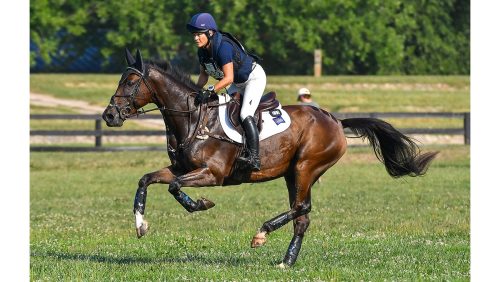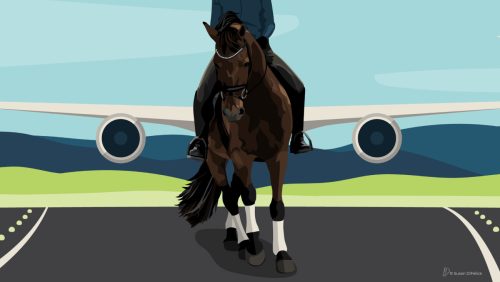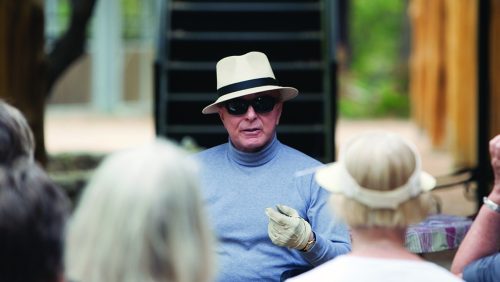In 2011 Kristi Wysocki was judging a show in Saugerties, New York, and during a break she wandered over and caught sight of riders competing in the USEF National Para-Dressage Championships. That night she joined the three para judges for dinner and started picking their brains about the sport.
“The judges were all foreign—there were no Americans judging it,” Wysocki recalled. “I spent the evenings with them, and all three were like, ‘You need to do this. It’s fun.’ I was like, ‘Yeah, I can give back to the sport that way.’ ”
Fast forward 11 years, and Wysocki has fallen in love with the sport. She’s the only U.S. Fédération Equestre Internationale five-star para-dressage judge, and she’s about to judge her third major international championship at the Orifarm Healthcare FEI Para-Dressage World Championships, Aug. 10-14 in Herning, Denmark.
“Once I started doing some shows I got really enamored with the riders and how hard they try,” she said. “They don’t ever go, ‘My horse won’t do [it].’ You don’t ever hear that.”
A Rising Standard
Wysocki, 60, is also an FEI 4-star dressage judge as well as a U.S. Equestrian Federation ‘S’ dressage and ‘R’ dressage sport horse breeding official. But para-dressage has a special place in her heart.

Kristi Wysocki, pictured here with Billy Bell, is the only five-star para-dressage judge in the United States. Kathleen Bryan Photo
She pointed out that judging para-dressage isn’t different from judging dressage, but that many U.S. judges don’t immediately understand that. She said that there used to be equivalency charts in the USEF “Rule Book” that equated Grade I competitions as intro level.
“When a national judge judged a Grade I rider, they would give them astronomically high scores because they were thinking of it as intro level,” said Wysocki, Coupeville, Washington. “Really Grade I is more like Prix St. Georges walk work. I say Prix St. Georges rather than Grand Prix because Prix St. Georges has to do more in the walk than Grand Prix does. You judge it just like you judge FEI-level dressage.”
Fellow five-star para-dressage judge Kjell Myhre said that many who are new to the sport think para-dressage would be too difficult to judge, but he said both rely on the same principles.
“The only difference is the visual picture of the rider,” said Myhre, who first met Wysocki at that Saugerties show and helped convince her to get involved with the sport. “The position you have to [ignore] a bit because it matters much more how [the rider] affects the horse. You still want the happy athlete. You want to have harmony and all the rest of what we look for in dressage, but the visual and position are a bit different. You can’t say, ‘You should sit more straight, and you should do this and that,’ because it’s not always possible.”
Wysocki admitted that was her biggest challenge initially, but now she focuses on the overall picture of the horse.
“The first time I went to Europe to judge I was in Mannheim [Germany], and I was up on the hill watching the warm-up the day before the show,” she said. “There was a rider who I was like, ‘Woo, she’s good.’ She had an amazing seat. It was probably at least five minutes before I realized she did not have legs. Then I became even more mesmerized. When you’re judging you have to put all the emotion aside and just judge what the horse does. You can’t think about the rider’s disability or having spasticity or not being very balanced. You learn how to not even see that and simply judge the horse’s performance.”
Since Wysocki started judging para-dressage, she’s seen the level of the sport skyrocket as more countries have started prioritizing it.
“You have to give Great Britain the biggest kudos for putting para on the map,” said Wysocki. “They really put a lot of attention on it. A lot of other European countries have supported it also. The United States decided to kick into gear a year before [the 2018 FEI World Equestrian Games in North Carolina] and has really made a lot of advancements in our country. We have multiple riders that are serious medal contenders now, and so is the country. The sport used to be owned by a couple countries; that’s not the case anymore; it’s anybody’s game now. That makes it so exciting. The standard is getting so high, and the quality of horses these riders are getting is really good.”
Staying Educated
During a championship, at the end of each day all the para judges—or dressage judges—convene and review their marks for each rider to discuss any big differences in scores. Judges may request video footage to check on a significant discrepancy, but Wysocki said that’s rare, and most differences are explained away through the angle where judges are sitting.
“It’s really important that we have these discussions, though,” said Wysocki. “I used to be way too tough on a short neck. I had to loosen up and still address it, but I was always too low if the horse had a short neck. Some judges might be really tough on a walk or not tough enough on a walk or whatever. So those conversations are how we make the judging better and better every year. By going through that many rides and being able to do it the same day, then you have recollection of what’s going on.”
Wysocki said that part of the reason there are only four FEI para-dressage judges in the United States has to do with the pipeline of para riders, specifically the lack of riders at the national level. But two things are helping to change that. First, in 2015 the USEF started recognizing Para-Equestrian Dressage Centers Of Excellence to grow the sport on a grassroots level. Also, the addition of the Adequan/USEF Para Dressage National Championship to the U.S. Dressage Festival of Champions (Illinois) this year should result in para classes at more national shows.
“That’s going to make the sport [more accessible] to people not in California or Florida but in Wyoming or Arizona or Oklahoma or Ohio or New England,” she said. “They’re going to suddenly feel like, ‘Hey, I can be part of this too.’ Because so far to this point, most riders had to compete in an international competition, which is extremely expensive just to be able to compete.”
ADVERTISEMENT
Another reason there aren’t many U.S. FEI para judges? It’s expensive. Wysocki estimates she spent $30,000 getting licensed. To get licensed one must first spend time shadow judging, wherein one marks a score sheet, which is compared to the judge’s. Then a prospective judge must spend a number of hours sitting with judges, who are usually at the five-star level. Wysocki fulfilled most of her requirements in Europe, where not only are there plenty of para judges but also more entries and more shows. She estimates that there are fewer than 10 entries in most U.S. CPEDIs but closer to 60 at European ones.
Having been through so much training, Wysocki is eager to share her knowledge. She and two international judges ran a voluntary webinar in February to help expose more judges to para-dressage, and over 100 judges signed up for the session.
“Anything she takes on she jumps into full force—there’s no halfway with Kristi,” said Natalie DiBerardinis, who served as co- chair alongside Wysocki on the U.S. Dressage Federation Sport Horse Committee. “If she’s going to do it, she’s going to put all her energy and time into doing it.”
Getting Hooked On Dressage
Wysocki grew up in a family of skiers, but she caught the horse bug early in her hometown of Golden, Colorado. After riding casually for a few years she started lessons at 10, riding with Bonnie Rose Sehlmeyer and then Sue Curry.
“The barn was an eventing, jumping, dressage and vaulting barn, and [we would go] swimming in the lake on the horses,” said Wysocki. “They had an instructor certification program there. We did it all, [and it was] super fun. Most of the kids even worked there some on weekends to help pay our board, [and we] learned horsemanship and barn skills too.”
Wysocki focused on eventing, deeming dressage too boring for much attention, riding her Thoroughbred mare Iduna through preliminary.
She took a break from serious riding while studying metallurgical engineering at the Colorado School Of Mines, then found herself in Texas for a year doing failure analysis for ARCO Oil and Gas. Her boss sent her to Alaska for a month so she could get experience in the field, and she fell in love with the area. A few months later she returned to Alaska.
“There wasn’t any eventing in Alaska because it’s too swampy, so I thought, ‘Well, I can focus on my dressage,’ ” she recalled. “I figured I’d be up there a year or two then head back. I stayed for 14 years and got hooked on dressage.”
Wysocki met her husband, Steve Wysocki, while working in the oil fields of the Prudhoe Bay on the North Slope, but she lived and kept horses in Anchorage and Wasilla. She was active in the dressage scene, which included eight shows in three months during the short summer season, and Kristi even flew her horse down to Seattle one year for USDF Regional Championships.
It was in Alaska that she met one of the most influential people in her early dressage career: Janet Foy.
“I was judging in Anchorage, and I was doing a clinic after the show, because they usually only have a one-day or two-day show, and by the time they fly someone up they want to do a clinic after,” said FEI five-star judge Foy. “So there were some wild pigs that came crashing through the place. All the horses went crazy. There was one horse running around, and it ran through the dressage arena, jumped a fence and ran back to the barn. There was this woman chasing the horse, and my scribe goes, ‘Oh, that’s Kristi. You’re going to stay with her for the clinic.’ That was my first introduction to Kristi.”
Kristi and Foy became good friends, with Foy becoming a regular visitor to Alaska, and Kristi riding with her whenever she got a chance during many a chilly clinic. When Kristi told Foy she was ready to leave the engineering business and turn her love of dressage into a profession, Foy suggested she call Hilda Gurney.
“I took a three-month working student-internship with Hilda Gurney, and I went from riding second level to Prix St. Georges in three months,” she said. “It was amazing. I cried a lot; it was not easy, but Hilda is an amazing person, and she gave me so many opportunities. It was also breeding season. That’s when I got interested in breeding, sitting up all night with the mares waiting for them to have a baby. That three months turned my world around.”
Kristi returned to Elbert, Colorado, where she ran a training program out of a 78-acre farm she built, developing a reputation for training horses no one else wanted to get on. She returned to Gurney’s annually to train for two to four weeks until her own business got too busy to permit long absences. She also ran a rehabilitation and therapy center for horses coming back from injuries and surgeries.

“I find each time I teach something, I learn even more,” said Kristi Wysocki. Erin Latterell Burk/Be Seen As You Are Photo
Over the years she competed in CDIs in California and traveled to Wellington, Florida, for one season during the first year of the Global Dressage Festival.
“I had the opportunity to ride some absolutely amazing horses,” said Kristi. “Guenter Seidel was on my right at one CDI. It’s like, ‘What place were you?’ ‘I can’t remember, but Guenter was on my right.’ It was great.”
The Call Of The Judge’s Box
In 1998, a year or so after Kristi returned to Colorado, she got a call that organizers needed one more person in an ‘L’ program.
ADVERTISEMENT
“Janet Foy was like, ‘You need to come do this,’ ” recalled Kristi. “I was like, ‘OK, I’ll learn something good.’ I really enjoyed it. Back then you had to be an ‘L’ for two years and judge a bunch of schooling shows before you could apply to be a small ‘r.’ I took the slowest, longest path they ever offered [to become a judge]. Now you can do it in less than half the time. I really enjoyed it and decided to get my small ‘r,’ and I got hooked on it.”
Three months after earning her ‘r’ license, she got a call from Lloyd Landkamer, who needed a last-minute official. Foy had recommended Kristi. She was thrilled at the opportunity and used her own air miles to book a ticket.
“I got to judge Lamplight my second horse show ever,” she said. “[Landkamer] took me under his wing and gave me so many incredible opportunities. He supported me in my FEI work and para work, and I wouldn’t be where I am today without his support.”
Kristi earned her FEI five-star para certification in July 2017 and her FEI four-star dressage license in 2018, and she’s already judged para-dressage at the 2017 Longines FEI European Championships (Sweden) and the 2018 Tryon WEG.
According to Foy, Kristi had all the pieces of a top judge from the beginning.
“[You need to have] attention to detail and the ability to multitask,” she said. “You have to be able to look at the entire horse, look at the big picture and go through the pieces. It’s like taking a bunch of change off the dresser and throwing it into the [counting] machine, and it goes chink, chink, chink and comes out with an amount. We have to think about every movement: what’s worth 50 cents, what’s worth a quarter, and what’s only worth a penny, and not make the penny the most important part.
“It’s a little like you buy a top 4-year-old horse, and say, this horse has the ability to be a Grand Prix horse, and by the time they’re 8 or 9 either they are or they’re not,” Foy added. “So you start with that raw material and hope for the best. I think Kristi had the desire and the intelligence and the drive to make it happen.”
Finding The ‘WY’
These days Kristi no longer runs her own barn, though she keeps two horses. She spends her time clinicing and judging; she was in Europe twice this spring to judge. Her business name, WY Dressage, is a play on two things: her name and the word why.
“I once had a student tell me she loved riding because I didn’t just tell her how to do it, but I also told her why,” she said. “That stuck with me.”
She also serves as chair of the USDF Sport Horse Committee, and she was awarded the 2019 USDF Volunteer of the Year award.
“Kristi is very creative,” said DiBerardinis. “[She’s] always trying to find [the answer to], ‘What is the next thing we need? Where is the hole?’ She brings a lot of energy to it, makes it easy to jump on the bus with her and go along for the ride.”
During the pandemic Kristi also started doing live videos on Facebook to educate to riders while they were locked down.
“I did several videos, some of which I was dressed in a horse costume, pushing a grocery cart around in the woods [or] having a fencing duel with a student, to demonstrate different things in riding,” she said. “I also gave many virtual lessons during that period from my home via computer to students around the country. They were a big hit. It got me to thinking that the online platform is not used enough in our sport.”
She created a course called “WY conformation and movement matter when buying, breeding and training dressage horses” as a self-paced online course that lasted about 12 weeks. Students from Canada, Mexico, Spain and Denmark joined U.S. ones, with 103 enrollees, and Kristi updated and relaunched the course in March of this year.
She’s also teaching a masterclass on the training scale via Zoom, and she plans to do additional courses with WY Dressage Academy.
“I think learning is one of the greatest gifts and adventures in life,” she said. “I love to learn, and I really love to give back and teach what I have learned. And I find each time I teach something, I learn even more.”
This article ran in The Chronicle of the Horse in our July 2022 Issue. Subscribers may choose online access to a digital version or a print subscription or both, and they will also receive our lifestyle publication, Untacked.
If you’re just following COTH online, you’re missing so much great unique content. Each print issue of the Chronicle is full of in-depth competition news, fascinating features, probing looks at issues within the sports of hunter/jumper, eventing and dressage, and stunning photography.













